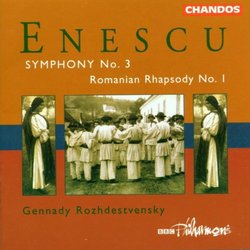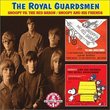| All Artists: George Enescu, Gennady Rozhdestvensky, BBC Philharmonic Orchestra Title: Enescu: Symphony No.3 / First Romanian Rhapsody Members Wishing: 0 Total Copies: 0 Label: Chandos Release Date: 7/21/1998 Genre: Classical Styles: Historical Periods, Modern, 20th, & 21st Century, Symphonies Number of Discs: 1 SwapaCD Credits: 1 UPC: 095115963326 |
Search - George Enescu, Gennady Rozhdestvensky, BBC Philharmonic Orchestra :: Enescu: Symphony No.3 / First Romanian Rhapsody
 | George Enescu, Gennady Rozhdestvensky, BBC Philharmonic Orchestra Enescu: Symphony No.3 / First Romanian Rhapsody Genre: Classical
|
Larger Image |
CD DetailsSimilar CDs
|
CD ReviewsA Balkan Late-Romantic Thomas F. Bertonneau | Oswego, NY United States | 08/05/2001 (5 out of 5 stars) "George Enescu's (1880-1955) Third Symphony in C-Major (1919-1921) surpasses even his Second in A Major (1916-1917) in the sumptuousness of its instrumentation and the largeness of its scale. The Second deploys a huge orchestra, which the Third not only duplicates but then bolsters by the addition of a wordless four-part chorus and an organ. Like the vast, late tone-poems of Richard Strauss or the feverish orchestral compositions of Alexander Scriabin, the symphonies of George Enescu seem ripe with narrative and philosophical import. Their proximity to World War One, in which Romania fought with the Allies, underlines the impression. If the Second be agitated and desperate throughout, managing only a mock victory in the martial apotheosis of the Finale, the Third traces a development from agitation and despair to something like conciliation or hope. The long First Movement (Moderato, Un Poco Maestoso [20.27]) begins quietly over a slow duple rhythm in the timpani; the mood remains dark, even as a trumpet signal attempts to light the scene from out of the depth. A theme in three-quarter time briefly clarifies the atmosphere, which returns, however, to brooding cloudiness. The trumpet-signal later becomes a richly harmonized fanfare, strongly reminiscent of those in Ernest Bloch's "Schelomo." The climax happens about thirteen minutes into the movement, where Enescu asserts the major key, only to let it subside in renewed minor-key disgruntlement. The opening material, with its timpani rhythms, returns with perfunctory ferociousness at the end. Rozhdestvensky paces this Moderato with fine calculation and, helped expertly by the Chandos engineers, brings out the subtleties of Enescu's orchestral counterpoint. The Second Movement (Vivace, Ma Non Troppo [15.21]) combines dance-like gestures with grotesque elements, somewhat in the manner of a Mahler scherzo. The gloomy and threatening march from the beginning of the Moderato resurfaces in a most glowering guise. The Third Movement (Lento, Ma Non Troppo), lasting nearly as long as the First, achieves its hard-earned relaxation with the help of the chorus and the organ. Enescu borrowed Cesar Franck's "cyclical" model for his First Symphony and used it again in both the Second and the Third. The Third's Lento thus retrieves material from the Moderato and the Vivace in altered form. The end comes quietly. The coupling is Enescu's Romanian Rhapsody No. 1 (1902), suitably energetic under Rozhdestvensky's direction. Musicologist Gabriela Ocneanu links Enescu to "impressionism" broadly construed as movement embracing not only Debussy's idiosyncratic harmony but Gregorian archaism as in Respighi and Eastern European folk-music exoticism as in Bartok and Janacek. She writes of Enescu that he "assimilated these currents so as to be able afterwards... to give [them] their full strength. In this way Enescu helped to reveal certain... essential characteristics of... human spirituality, which thus could appear and grow at [a] favorable moment." Rozhdestvensky's performances underline Ocneanu's argument. A magnificent disc, with an attractive booklet (photographs of Romanian folk-life on the cover) and decent, if not excellent, notes. Recommended." Enescu's Symphony No. 3 is a 20th cen. musical masterpiece gaspar | 03/18/1999 (5 out of 5 stars) "The highlight of this well-recorded and inspiredly conducted program is Enescu's Symphony No. 3, a musical masterpiece by all accounts. Not to be missed is its third movement's wordless chorus-- a divine inspiration. Also recommended are Enescu's 2nd Symphony and, especially, his masterpiece, the opera "Oedipe"." One of the best symphonies in the History of Music gaspar | Tenerife, Canary Islands SPAIN | 05/25/2002 (5 out of 5 stars) "When I listened Enescu's music for the first time I couldn't understand how a composer like this has remained relatively unknown in comparisson with other contemporaries.
His Symphony nº3 is one of the undoubted masterpieces of Symphonic Music. It depicts pictorially the three "Worlds" -Earth, Hell and Heaven (in this order)- in a "Respighian" way, with a superb orchestral colour and solemnity, magnified by the use of piano, organ and a worldless chorus in the third movement. The climax of the second movement is absolutely impactant, with the brass reaching uncommon Heights of power and violence as the prince of darkness enters the scene. In contrast, the peaceful and idylic third movement seems to lift the listener, by the end of the symphony, "à la Scriabin", as if he were on a cloud way to Heaven. An absolute masterpiece. PURE MUSICAL GOLD in this superb recording." |

 Track Listings (4) - Disc #1
Track Listings (4) - Disc #1

